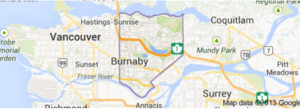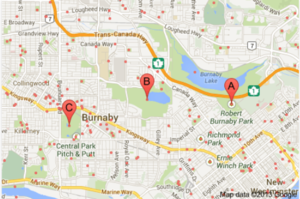Course:GEOG350/Archive/2013ST1/Deer Lake Burnaby
Burnaby is a city in British Columbia, Canada and an integral part of Metro Vancouver. The city has various inner city lakes and parks that become rare characteristics that distinguish it from other cities in the province. Deer Lake Park is one of these lakes, and the focus of this page. Since its foundation, the urban landscape of the city has been growing around this lake-park park since the 1950s, and continues to grow as the city urban planners face new challenges to accommodate the vastly growing population.[1] Deer Lake Park has also been providing the local residents with invaluable recreational opportunities for decades. However, the lake’s aquatic and terrestrial recreational future is being questioned as the lake’s integrity is being threatened by urbanism as it reaches new levels. Furthermore, Deer Lake Park has been providing residents a variety of options for them to maintain their health. If the aesthetic and environmental aspects of the lake are not protected in the near future, Burnaby will have lost its best natural recreational facility.
Deer Lake Park, Burnaby
Boundaries

Burnaby has the city of Vancouver to the West and the city of Coquitlam to the East. It has two natural borders: the Burrard Inlet to the north and the Fraser River to the south. Located to the south-west is the city of New West Minister.
Within Burnaby, Deer Park Lake refers to the eighty-six acre land with the lake as the most prominent feature of the park. [1]
Notably, the city is blissfully replete with parks. Figure 2 shows some of the biggest parks including Burnaby Lake, Robert Burnaby Park, Squint Lake Park, Central Park, Kensington Park, and Discovery park, which shares its spaces with Simon Fraser University. Deer Lake Park is adjacent to other major features: the Institute of Technology to the north-west, and Burnaby Lake which is separated by the Trans Canada Highway and the Canada Highway.

History
The history of Deer Lake Park is intrinsically tied to the story of Burnaby. According to its Wikipedia soure, Robert Burnaby founded the city near the freshwater lake with the purpose of making it the city's “geographical centre”. Four decades later, the nearby cities of New Westminister and Vancouver influenced the growth of Burnaby, effectively rendering it a suburb of Vancouver. Like many other cities, Burnaby went from a rural and agricultural phase into the urban landscape it is today. Additionally, the industrial and commercial firms such as the Metropolis at Metrowtown commercial mall, have spurred a growth in population. Other factors nfluencing the growth of Burnaby include the funding of the Simon Fraser University and British Columbia (SFU) and The Institute of Technology (BCIT). The good educational reputation of these institutions attracts thousands of commuters consistently into Burnaby each day.
Additionally,the ratio of park land to residents “is the highest in north America”. [2]
Demography
According to the 2010 Sub-Provincial Population Estimate, the population of Burnaby is 227, 389.[3] From that estimate, the city is home to a very diverse demography: whites, south Asian, Chinese, Black, Filipino, Latin American, Arab, South East Asian, Korean, Japanese, and Aboriginal groups including First Nations People, Metis, and Inuit. All of which have access to the lake park.
Transportation Infrastructure
Metro Vancouver is no stranger to policies promoting environmentally conscious alternatives. In fact, the Vancouver's Livable Region Strategic Plan was passed in 1996 to implement "aggressive steps...to...protect the regions Green Zone (agricultural and environmentally significant lands). Some of the ways in which the plan is implemented is by easing the connection between areas of high density through "commuter train, passenger ferry, light-rail transit, rapid bus, and...local bus". [4]
Introduction of Issue

The issues surrounding Deer Lake Park are environmental, urban, and political. The urban growth and increasing population density have transformed the various ways in which the residents utilize the lake. As the needs of the local populace change, so do the park’s features.
The park’s environmental issues are complex and unbalanced. Urban planners face two seemingly contradictory challenges consisting of properly accommodating the inhabitant’s needs and of protecting the lake-park’s ecology. If these two factors are merged successfully, the lake park can be preserved for the leisurely use of future generations.
The park’s surrounding urban issues involve the ever-appealing human fondness for water-facing properties. This could not be more true than in the case of Deer Lake Park. High-density condominiums are facing the park and more will be constructed in the near future to accommodate the demand. Currently, there is a committee dealing with alternatives to restore the ecological health of Deer Lake, but the issue remains unresolved. More policies are currently needed to protect the park and the resident’s interests.
Citations of academic sources
- ↑ 1.0 1.1 Cherneff, M.D. Multiple Account Evaluation of an Urban Lake Rehabilitation and Management Proposal: A Case Study of Deer Lake. Dissertation, Simon Fraser University. 1990.
- ↑ http://en.wikipedia.org/wiki/Burnaby#cite_note-1
- ↑ http://en.wikipedia.org/wiki/Burnaby#cite_note-1
- ↑ Girling, Cynthia. UniverCity: Building a new Green Neighbourhood. Climate Change and Place: Mitigation, Adaption and Uncertainity. No Specified Year, post-1996.